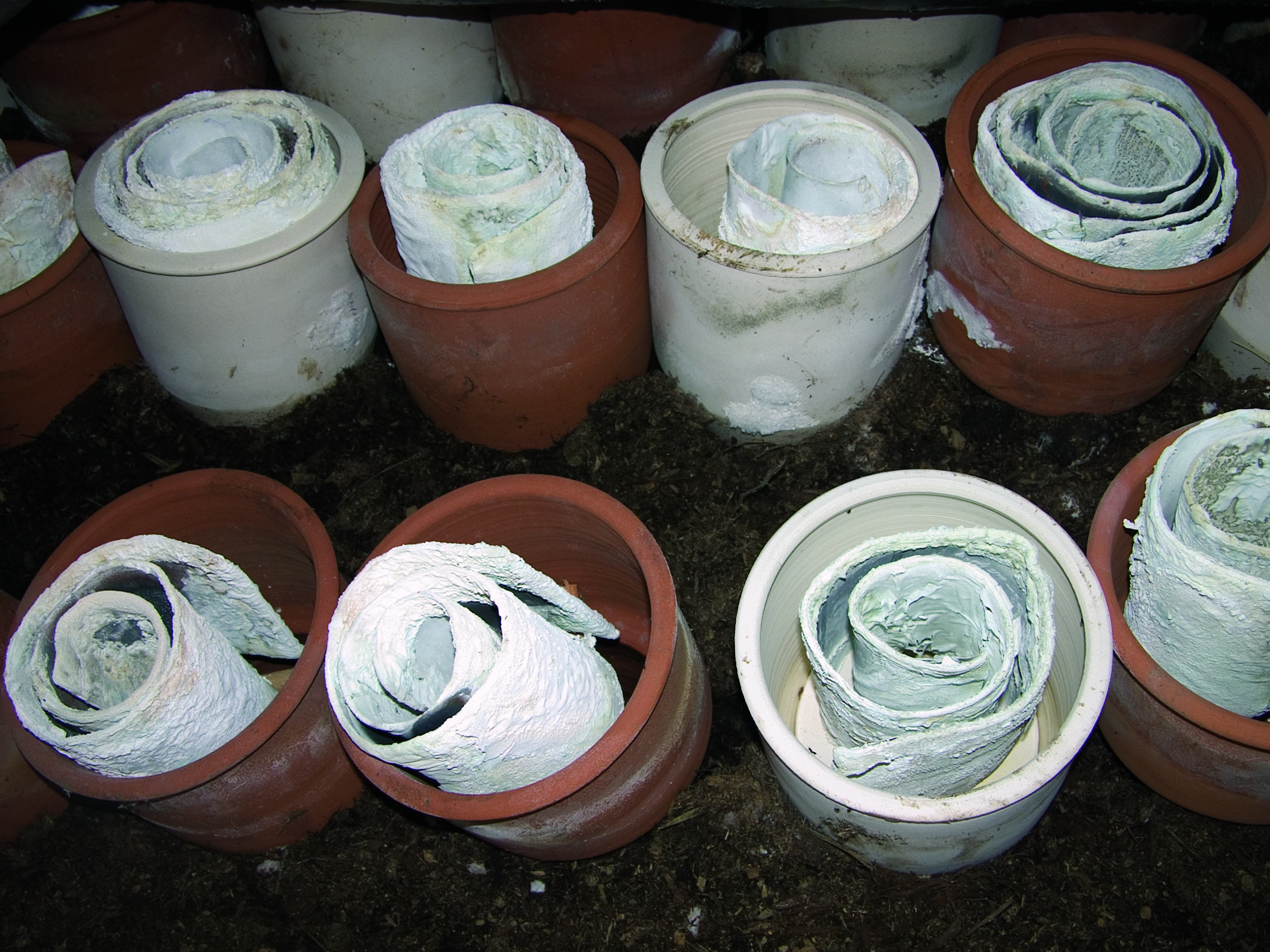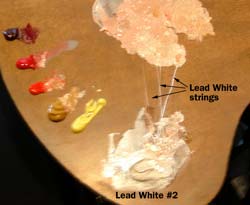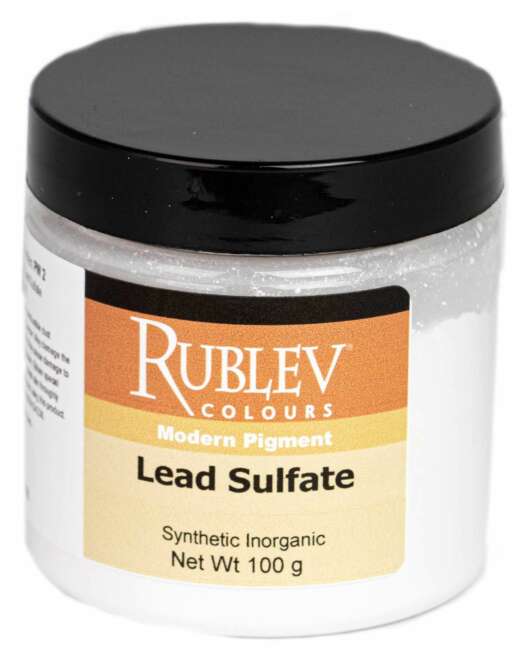
Natural Pigments presents Choosing the Best White for Your Oil Painting from the Artist Materials Advisor playlist. The video features the properties of Rublev Colours white artist oils: Crystal Lead White, Mica Lead White, Venetian White, Ceruse (Lead White) (Loot Wit), Flemish White (Lead Sulfate), Lead-Titanium White, and Mixing White.
The Historical Significance of Lead White in Art
Lead white is the most important white pigment used in painting throughout history. It was known to the ancient Egyptians, Greeks, and Romans and was commonly used to prepare ointments, plasters, and cosmetics. Pliny first identified it in the literature as a pigment, mentioning it, among other colors, as used by the ancients to paint ships.
Lead white is basic lead carbonate 2PbCO3·Pb(OH)2, a complex salt containing carbonate and hydroxide ions. It occurs naturally as a mineral known as hydrocerussite, a hydrate of cerussite. The mineral is rare, so lead white has been made synthetically throughout history. Synthesized lead white appeared in Greece during the fourth century B.C.E. Since then, lead white has been produced on a large scale and was widely used in painting and cosmetics across Europe. However, when and how synthetic lead white appeared in East Eurasia is unclear. One study shows that the synthesis of lead white may have evolved independently in East and West Eurasia during the first millennium B.C.E. The mass production of synthetic lead white promoted its widespread use in makeup in China and the Mediterranean World, which triggered a cosmetic revolution and stimulated the development of chemistry in human history, especially the earliest practices in China.
The Composition and Properties of Lead White
Lead white oil paint is made by grinding basic lead carbonate (the chemical name for lead white pigment) in vegetable drying oil. Normal lead carbonate (PbCO3) or other lead carbonate compounds have often been mistakenly identified as basic lead carbonate, which has the chemical formula 2PbCO3•Pb(OH)2. The different varieties of lead carbonate have not been reported in paintings except as impurities. Basic lead carbonate contains 25 to 30 percent lead hydroxide, distinguishing it from normal lead carbonate. It is this element that gives added opacity to lead white. It also gives it the qualities of oil paint often sought by artists.
The density of lead white and its opacity is critical to painters. If lead white were not dense and opaque, it would be necessary to put it on thickly where, since it is both dense and opaque, a thin coat of it will serve. The power it gives when making strokes of light as incisive as strokes of dark paint is fundamental to the painting technique.
The Role of Lead White in Oil Painting Techniques
Lead white also serves to preserve the flexibility of oil paint, extending the life of the paint film. In a posting on the AMIEN forum, Dr. Jaap Boon, University of Amsterdam and AMOLF and formerly head of the MolArt Project, offered these crucial insights into the role of lead white in oil paint film:
“The role of lead white is multiple. It is a bulk drier that means homogenous drying over the paint film. It reacts with free acids that develop by oxidation of the oil. It links the acids groups of C9 diacids even when they are still acylglycerides thus stabilising the early film (proven by NMR work of Michiel Verhoeven in 2006). At a later stage when the biological ester bonds are gone, it further stabilises the diacids to form a network that is hard to break. And furthermore, it provides a filling material and surfaces for oil-derived compounds to dock.”
“No lead means that something else has to take over these roles. I don’t think that that magical material has been found yet simply because we only very recently have begun to understand the molecular structure of paints. It is my belief that the period 1950–2000 will bring us many defects in the oil paints that are now maturing. It is time that we develop a molecular level understanding on how to deal with oil paint defects that develop when the network can’t be stabilised with suitable metal cations.”
Distinguishing Flake White and Cremnitz White
What is “Flake White”?
When you see a tube of oil paint labeled “flake white” or “Cremnitz white,” what pigment does it contain? Most artists’ material manufacturers call flake white—a mixture of basic lead carbonate and zinc oxide ground in vegetable oil (usually linseed or safflower). Cremnitz white, on the other hand, is typically pure basic lead carbonate ground in vegetable oil.
Lead white has been made since antiquity using variations of the process known as the “stack process” or “Old Dutch” method, whereby lead is exposed to acetic acid vapor in the presence of moisture and carbon dioxide; the latter is generally provided by fermenting matter (horse manure, waste grape skins, tanbark), which also provides a constant source of heat. In this process, the air supplies the oxygen, while the fermenting matter produces carbon dioxide and moisture. Acetic acid, in the form of vinegar, converts the lead, forming basic or tribasic lead acetate, which is afterward decomposed by carbon dioxide to form basic lead carbonate. Stack process lead white, and its related Krems process differs from methods used to manufacture basic lead carbonate today, based on an electrolytic process. The results of the Dutch and Krems methods are basic lead carbonate, but the size and shape of the pigment particle are quite different, giving these whites other properties in paint. A more detailed discussion of the stack process can be found in Stack Process White Lead—Historical Method of Manufacture.
The term “flake white” comes from the scales or flakes (see the main image above) of basic lead carbonate that appears on corroded lead in the stack process or the old Dutch method of making the pigment. The modern process does not result in flakes of basic lead carbonate but rather the pigment deposits as fine sediment in a wet process. The particle size and morphology (crystal structure and particle shape) of the stack process lead white is a critical factor that differentiates this pigment from modern lead white.
What is “Cremnitz White”?
The name Cremnitz white is a variant spelling of Kremnitz, derived from the German name of the Slovak town Kremnica. This town was mistakenly associated with the commercial name Kremsweiss (German) or Krems white, famous in the 18th and 19th centuries. Krems white was manufactured in Klangenfurt, Austria, but the name was probably derived from the galena (a lead ore) mines near the small town in lower Austria, Krems, now called Krems an der Donau. Krems white was deemed superior to any other lead white during the 19th century. It is perhaps why artists’ materials manufacturers chose this name to designate their pure lead white oil paint.
Innovations in Lead White: Rublev Colours Artist Oils

Rublev Colours Lead White #2 is an opaque white that is soft, ropy, or “stringy.” The ropy consistency of Lead White #2, also called “long,” results from using walnut oil without additives. Long paint pulls with the brush and, for this reason, is often preferred by artists because it flows with your brushstroke, enabling long lines. This effect can be seen in the image at the right. Lead White #2 is brighter than Rublev Colours Lead White because it is ground in filtered, pale walnut oil.
Because Rublev Colours Lead White #2 is ground with basic lead carbonate made according to modern practice, we chose to name it “Lead White” so as not to confuse artists with lead whites made according to the stack process or Krems process named “Flake White” and “Krems White,” respectively.

The image above is a drawdown of Rublev Colours Lead White #2 oil paint. The drawdown on the left is the color at full strength at three mils (0.003 inches) thickness over a black and white chart. The drawdown on the right is one part of the lead white mixed with three parts bone black. The lower part of the drawdowns was scraped to show the color of the undertone.
Additives in Modern Lead White Oil Paint
Additives are used in modern oil paint to help prevent the pigment and oil from separating during storage and aid in grinding the paint. Rublev Colours Lead White #2 contains basic lead carbonate (made according to modern processes) without additives or fillers to alter the pigment characteristics in the oil. As a result, you get a higher pigment volume concentration (PVC) than other brands of lead white (flake white)—as high as 45%. This means most brands of flake white do not weigh nearly as much as a 50 ml tube of Rublev Colours Lead White #2. Yet, Rublev Colours Lead White is not stiff and mixes well with all other oil colors.
Additives used by all other manufacturers include beeswax, hydrogenated castor oil, and aluminum or magnesium stearate. These ingredients amount from one to two percent of the pigment weight in the formula. Although this is a comparatively small amount, additives change the behavior of the pigment in oil because they increase the oil’s viscosity, giving the paint a buttery, short consistency.
Rublev Colours Artists’ Oils are traditional oil paints because they are made according to historical methods, such as those in the 19th century, when modern additives were not used in artists’ paint.
The Future of Lead White in Artistic Practice
As we look to the future, the legacy of lead white in artistic practice continues to be both revered and critically examined. With advancements in safety, environmental considerations, and alternative materials, the role of lead white evolves. Yet, its unparalleled qualities ensure it remains a subject of study, admiration, and selective use among artists who seek to connect with traditional methods while embracing modern innovations. The dialogue between its historical significance and future potential underscores the enduring quest for excellence and authenticity in art.
Frequently Asked Questions
Why is lead white banned?
Lead white is banned in many countries due to its toxicity and potential health risks, including lead poisoning. This ban aims to protect public health, especially that of artists and consumers of art materials. Lead wbite is not banned in the United States and Canada. Lead white can be purchased in the European Union if it is used for professional applications. Different countries of the European Union have different requirements for purchasing lead white.
When did artists stop using lead white?
The use of lead white has significantly declined over the past century due to health concerns and the development of safer alternatives. However, it is still used by some artists who prefer its specific properties.
Is lead white legal?
The legality of lead white varies by country. Due to its toxic nature, it is banned or restricted to professional use under controlled conditions in some places.
How toxic is lead white paint?
Lead white paint is a chronic toxic if ingested or inhaled. It poses serious health risks, including lead poisoning, which can affect the nervous system and internal organs.
Is lead white toxic?
Yes, lead white is toxic. Its ingestion or inhalation can lead to lead poisoning, which is detrimental to human health and impacts various bodily functions and systems.
Is lead harmful if touched?
Lead can be harmful if touched, as it can be absorbed through the skin, though the primary routes of lead poisoning are ingestion and inhalation. It is crucial to use protective measures when handling lead-containing materials.
Natural Pigments presents part two of Art Materials Advisor, A Paler Shade of White. Tatiana Zaytseva and George O’Hanlon discuss the drying time, yellowing, and mixing properties of Rublev Colours white artist oils: Lead White No. 1, Lead White No. 2, Stack Process Flake White, Barite, Lithopone, and Titanium White.
Note: The video was released shortly after the COVID pandemic when supply chains of lead white pigment were seriously interrupted. The supply of lead white pigment has resumed to the levels that existed before the pandemic.











